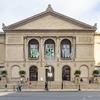More about The Crucifixion

Sr. Contributor
It has been noted that Francisco de Zurbarán was not one to show a lot of blood or graphic details in the many paintings he did of martyrs, saints, and the crucifixion of Christ.
This version of The Crucifixion (or Christ on the Cross) is no different; although there is visible blood, it’s kept to a minimum. Zurbaran painted another version a few years after this one, also Christ on the Cross, (yes, confusing) which is on display at the Museo Nacional Thyssen-Bornemisza, and shows no visible blood at all. Then there is the sad case of Saint Serapion, also by Zurbarán; the saint was horribly tortured to death, but Zurbarán again chose to depict him with no visible wounds or blood.
This might be one of the more realistic depictions of the crucifixion of Christ on the cross, if early commentary can be believed. When it was mounted at its original location, in the (not very well lit) sacristy of the Monastery of San Pablo, behind a protective grill, there were those who thought it was three-dimensional, lifelike as it was. A century after it was painted an admirer declared that “all those who see it and do not know that it is a painting believe it to be a sculpture.”
The Crucifixion is Zurbaran’s first signed and documented painting, completed in 1627, and was commissioned by the order of the Dominicans to hang in their monastery. In this instance, Zurbarán followed the example of another Spanish painter, Francisco Pacheco, who thought that the crucified figure of Christ should be depicted using four nails, instead of the usual three. What this meant is that instead of his feet being crossed, they were now side by side. While this may seem like a small detail, it was new at the time and led to this style being much more commonly used in Spain. The use of three nails versus four nails affects how the figure is painted, as it can determine the way the body sags or leans, assuming the artist is after realism.
The Crucifixion is notable not only for its natural appearance, but also because it shows Christ as an isolated figure, or an icon; there are no spectators, soldiers, mourners, other condemned men, nobody at all. There is no hint of landscape or sky, just a bit of an archway, perhaps to match the space where it was hung. It’s almost as if the cross is suspended in the darkness of space, which makes it all the more dramatic. The practice of painting a crucifixion in this manner can be attributed to the same man who advocated for the four nails, Francisco Pacheco.
There are thousands of paintings that feature the crucifixion of Christ as the main subject, with Zurbarán painting his fair share of different versions (around a dozen). This version was hailed as a masterpiece back when it was first unveiled, and remains one of Zurbarán’s most recognized and lauded works.
Sources
- “Baroque: Francisco De Zurbarán.” Spanish Art. https://www.spanish-art.org/spanish-painting-zurbaran.html.
- “Crucifixion.” art, May 2018. http://www.art-theoria.com/painting-of-the-month/crucifixion/.
- Baticle, Jeannine. Zurbarán The Metropolitan Museum of Art, New York, September 22-December 13, 1987: Galeries Nationales Du Grand Palais, Paris, January 14-April 11, 1988. New York: Metropolitan Museum of Art, 1987.
- Brown, Jonathan. Francisco De Zurbarán. New York: H.N. Abrams, 1973.
- Brown, Jonathan. Painting in Spain 1500-1700. New Haven: Yale University Press, 1998.
- Soria, Martin S. The Paintings of Zurbarán, Complete Edition by Martin S. Soria. London: Phaidon Press, 1953.
Featured Content
Here is what Wikipedia says about Christ on the Cross (Zurbarán)
Christ on the Cross is a 1627 oil painting on canvas by the Spanish painter Francisco de Zurbarán, now in the Art Institute of Chicago.
In 1626 Zurbarán signed a new contract with the Dominicans of San Pablo de Real Monastery in Seville to produce 21 paintings in 8 months. One of these was Christ on the Cross, which was so admired by the artist's contemporaries that Seville's city council suggested he moved there permanently in 1629.
As in Diego Velázquez's 1632 Christ Crucified, the artist shows Christ's two feet nailed separately – the number of nails used to crucify Christ was then a matter of controversy, with Bridget of Sweden writing of four nails. Both works also draw on a Counter Reformation trend after the Council of Trent to depictions focusing solely on Christ rather than those gathered around the cross.
Check out the full Wikipedia article about Christ on the Cross (Zurbarán)













I like this painting. Because it depicts the crucifixion scene of Jesus vividly. It is simple but depicts the image of Jesus in great detail. It makes me feel the pain of Jesus when he was crucified. At the same time, it reminded me that I should be grateful and thankful. Jesus was sinless, yet he was crucified for the sake of the world. He cleansed us from our sins with His precious blood.